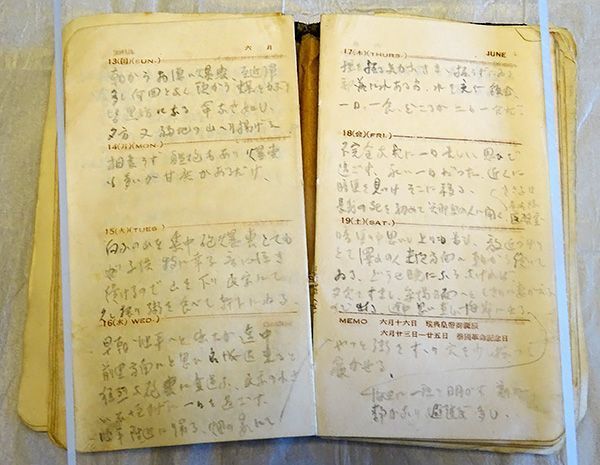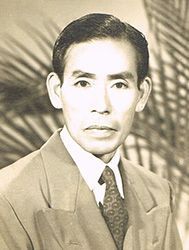Journal details Okinawan residents being “ordered to leave cave shelters” by the Japanese army during the United States army’s assault in the Battle of Okinawa

The journal detailing the experiences of Tatsusei Yogi and his family during the battle of Okinawa
June 29, 2020 Ryukyu Shimpo
By Hideki Matsudo
A journal that belonged to an office worker from Mawashi village (now the Mawashi neighborhood of Naha) that details escaping to the southern part of Okinawa’s main island with his family during the Battle of Okinawa when he was 38, has been discovered. The man was Tatsusei Yogi (deceased 1988), an employee of Osaka Shosen Kaisha Lines’ (O.S.K. Lines) Naha Branch. In the journal, he details being evicted from his cave shelter and being directed to an evacuation site by the Imperial Japanese Army (IJA) in the midst of the U.S. army’s violent attack along with his wife Chiyo (35 years-old at the time), who was from Hawaii, two sons, two daughters, and his father Tatsuzen (75 years-old at the time), writing, “In addition to being told to leave the shelter, we were again ordered to evacuate to Tamagusuku.”
According to the Battle of Okinawa historians, this is the first primary written account of Okinawan’s evacuating during the bloody battle in the south of Okinawa’s main island.
Masaie Ishihara (emeritus professor Okinawa International University – OIU), a scholar of the Battle of O

Tatsusei Yogi
kinawa, indicates, “The Japanese government covered up the evictions by claiming that the residents offered up the shelters due to need in the Imperial Japanese Army, and then conferred the status of combatant to residents who perished in the Battle of Okinawa, paid a survivor’s benefit to their families, and enshrined them at Yasukuni Shrine. However, according to Yogi’s journal, there is certainly no reading of it where the residents were acting like combatants and offered up the shelters to the military.”
The journal was written in a 12.5 cm by 7.5 cm Nippon Yusen sailor’s notebook. Tatsusei recorded his daily experiences including the U.S. military’s attacks and the IJA’s eviction orders from the 10/10 Air Raid on October 10, 1944 through June 20, 1945, when the U.S. assumed control of the island.
The journal includes entries such as one from May 26, 1945 in Makabe (Itoman City) he wrote “[We were] kicked out of our cave shelter,” and later that year on June 2 in Tamagusuku (Nanjo City) “[We were] ordered to evacuate the cave shelter,” detailing the experience of evacuating to southern Okinawa, and finally finding a cave shelter only to be ordered to leave by the IJA. It appears that the IJA was more concerned with their own safety than protecting Okinawans.
The journal also describes a lack of consistency between the IJA and police; after being directed to evacuate Tamagusuku in Nanjo and head to Makabe in Itoman, they were told to go back to Tamagusuku, causing them to roam an active battlefield. There are also entries describing food being shared, “Someone shared some horse meat with us,” (May 8, 1945), showing a group citizens who still managed to work together during an extreme situation.
The family at one point lost sight of the father, Tatsuzen, and their oldest daughter, eight-year-old Emi, while traveling from central Okinawa south. They were reunited with Emi 10 days later, but Tatsuzen was nowhere to be found. The eldest son, Takenobu (six years old at the time) died from illness in August, 1945.
The journal was edited by the second son, Takashi, 77, based on stories he heard from his parents, and had the journal translated into English and publicly released after Tatsusei’s death in 1988. The notebook the diary was recorded in was donated to the Okinawa Prefectural Peace Memorial Museum by relatives in October, 2007.
(English translation by T&CT and Sam Grieb)
Previous Article:Gov. Tamaki shares his mother’s words and lesson learned from WWII: ‘Life is precious’
Next Article:Little terns: Nurturing love in material storage area
[Similar Articles]
- One of the largest wartime shelters discovered in northern Okinawa found in Motobu
- A large quantity of ordnance found in Itoman
- Some of Okinawan seen as spies in the Japanese Imperial Army documents during the Battle of Okinawa
- Praying for life-saving cave and peace at Shiohira Gongen Festival
- Walking Study Tour on the Battle of Okinawa From the Haebaru Army Hospital Cave to Itokazu Cave
 Webcam(Kokusai Street)
Webcam(Kokusai Street)


